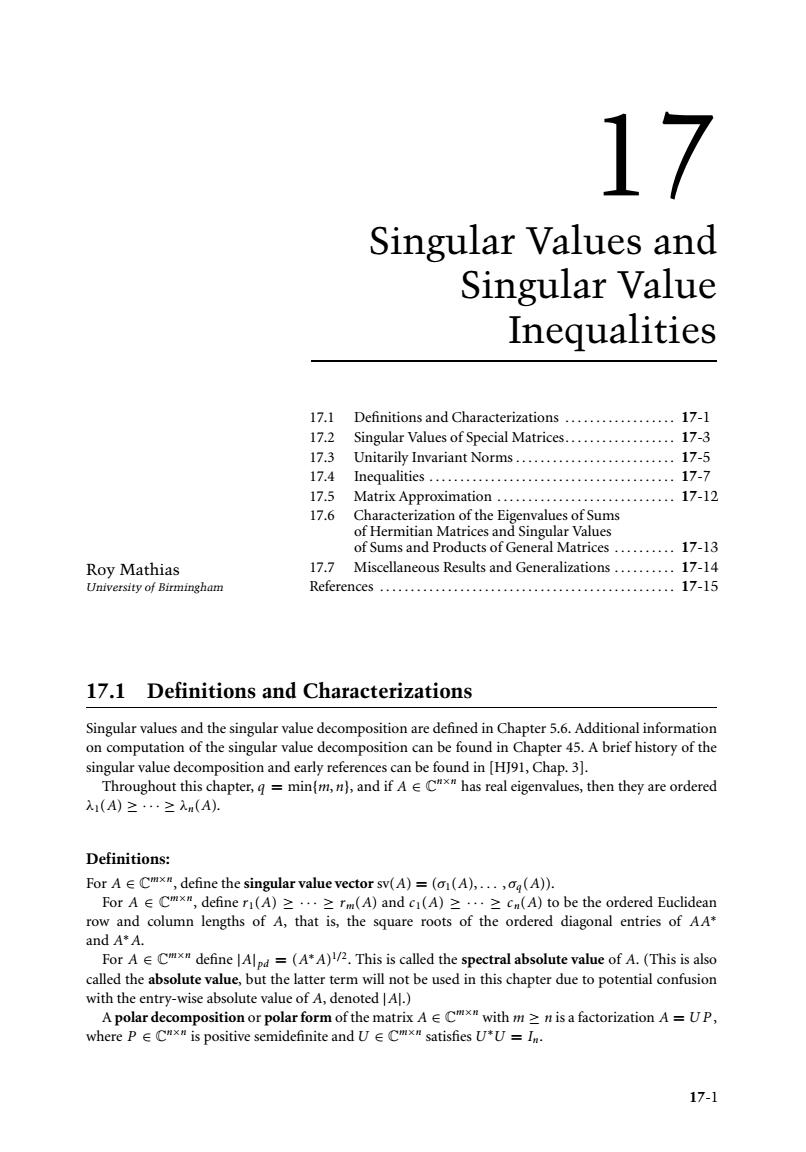正在加载图片...

17 Singular Values and Singular value Inequalities 17.1 Definitionsand Characterizations 17-1 173 17.5 17-7 atrix Approxima 17-12 176 of Sums and Products of General Matrices17-13 Roy Mathias 17.7 Miscellaneous Results and Generalizations..........17-14 University of Birmingham References.....17-15 17.1 Definitions and Characterizations Singular values and the singular value decomposition are defined in Chapter 5.6.Additional information on computation of the singular value decomposition can be found in Chapter 45.A brief history of the singular value decomposition and early references can be found in H9,Chap.3]. Throughout this chapter,=min(m,n),and if ACx"has real eigenvalues,then they are ordered 1(A)≥..≥入n(A). Definitions: For A Cx",define the singular value vector sv(A)=(a(A),...(A)). ForA∈Cmxm,definer(A)≥·≥rm(A)and ci(A)≥…≥cn(A)to be the ordered Euclidean row and column lengths of A,that is,the square roots of the ordered diagonal entries of AA* and A*A. For ACdefine l(AA).This is called the spectral absolute value of A.(This is also called the absolute value,but the latter term will not be used in this chapter due to potential confusion with the entry-wise absolute value of A,denoted Al.) m of e matrix A∈C a factorization A=UP, is positive semidefinite andUC satisfies U'U =I 17-1 17 Singular Values and Singular Value Inequalities Roy Mathias University of Birmingham 17.1 Definitions and Characterizations .................. 17-1 17.2 Singular Values of Special Matrices.................. 17-3 17.3 Unitarily Invariant Norms .......................... 17-5 17.4 Inequalities ........................................ 17-7 17.5 Matrix Approximation ............................. 17-12 17.6 Characterization of the Eigenvalues of Sums of Hermitian Matrices and Singular Values of Sums and Products of General Matrices .......... 17-13 17.7 Miscellaneous Results and Generalizations .......... 17-14 References ................................................ 17-15 17.1 Definitions and Characterizations Singular values and the singular value decomposition are defined in Chapter 5.6. Additional information on computation of the singular value decomposition can be found in Chapter 45. A brief history of the singular value decomposition and early references can be found in [HJ91, Chap. 3]. Throughout this chapter, q = min{m, n}, and if A ∈ Cn×n has real eigenvalues, then they are ordered λ1(A) ≥···≥ λn(A). Definitions: For A ∈ Cm×n, define the singular value vector sv(A) = (σ1(A), ... , σq (A)). For A ∈ Cm×n, define r1(A) ≥ ··· ≥ rm(A) and c1(A) ≥ ··· ≥ cn(A) to be the ordered Euclidean row and column lengths of A, that is, the square roots of the ordered diagonal entries of AA∗ and A∗A. For A ∈ Cm×n define |A|pd = (A∗A)1/2. This is called the spectral absolute value of A. (This is also called the absolute value, but the latter term will not be used in this chapter due to potential confusion with the entry-wise absolute value of A, denoted |A|.) A polar decomposition or polar form of the matrix A ∈ Cm×n with m ≥ n is a factorization A = U P , where P ∈ Cn×n is positive semidefinite and U ∈ Cm×n satisfies U∗U = In. 17-1